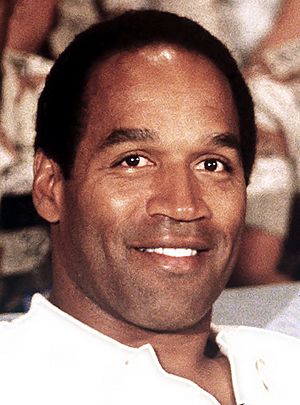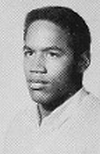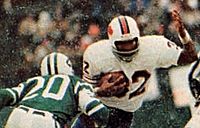O. J. Simpson facts for kids

Simpson in 1990
|
|||||||||||||||
| No. 32 | |||||||||||||||
|---|---|---|---|---|---|---|---|---|---|---|---|---|---|---|---|
| Position: | Running back | ||||||||||||||
| Personal information | |||||||||||||||
| Born: | July 9, 1947 San Francisco, California, U.S. |
||||||||||||||
| Died: | April 10, 2024 (aged 76) Las Vegas, Nevada, U.S. |
||||||||||||||
| Height: | 6 ft 1 in (1.85 m) | ||||||||||||||
| Weight: | 212 lb (96 kg) | ||||||||||||||
| Career information | |||||||||||||||
| High school: | Galileo (San Francisco, California) |
||||||||||||||
| College: | CCSF (1965–1966) USC (1967–1968) |
||||||||||||||
| NFL Draft: | 1969 / Round: 1 / Pick: 1 | ||||||||||||||
| Career history | |||||||||||||||
|
|||||||||||||||
| Career highlights and awards | |||||||||||||||
|
|||||||||||||||
| Career NFL statistics | |||||||||||||||
|
|||||||||||||||
| Player stats at PFR | |||||||||||||||
|
Pro Football Hall of Fame
|
|||||||||||||||
|
College Football Hall of Fame
|
|||||||||||||||
Orenthal James Simpson (July 9, 1947 – April 10, 2024) was a famous American football player, actor, and broadcaster. He played in the National Football League (NFL) for eleven seasons. Most of his career was with the Buffalo Bills. Many people consider him one of the greatest running backs of all time.
Simpson played college football for the USC Trojans. In his final year, he won the important Heisman Trophy. The Bills then chose him as the first overall pick in the 1969 NFL/AFL draft. During his nine years with the Bills, he was chosen for the Pro Bowl five times in a row, from 1972 to 1976. He also led the league in rushing yards four times and in rushing touchdowns twice. In 1973, he became the first NFL player to run for more than 2,000 yards in one season. He is the only player to do this in a 14-game season. He still holds the record for the most rushing yards per game, with 143.1 yards.
After ending his football career with the San Francisco 49ers in 1979, he became an actor and a sports commentator. He was recognized for his amazing football skills by being inducted into the College Football Hall of Fame in 1983 and the Pro Football Hall of Fame in 1985.
O. J. Simpson passed away from prostate cancer on April 10, 2024, at the age of 76.
Early Life and Football Beginnings
Orenthal James Simpson was born in 1947 and grew up in San Francisco, California. His mother, Eunice, worked as a hospital administrator. His father, Jimmy Lee Simpson, worked for the Federal Reserve Bank and as a bank custodian.
Simpson's aunt gave him the name Orenthal. She said it was the name of a French actor she liked. Everyone called him "O.J." from the time he was born. He didn't even know his full name was Orenthal until a teacher read it in third grade.
As a child, Simpson had a condition called rickets. He had to wear braces on his legs until he was five years old. This gave him his bowlegged stance. After his parents separated in 1952, O.J. and his sister were raised by their mother.
Simpson lived with his family in the housing projects of the Potrero Hill neighborhood in San Francisco. He played football for the Galileo Lions at Galileo High School (now Galileo Academy of Science and Technology). He finished high school in 1965.
College Football and Track Career
Even though Simpson was a great football player in high school, his grades weren't good enough to get him into many colleges. In 1965, he enrolled at City College of San Francisco. He played both running back and defensive back for their football team. He was named a Junior College All-American as a running back. Many colleges wanted him to transfer to their football programs.
Simpson chose to go to the University of Southern California (USC). He had always admired USC's football team. He played running back for the Trojans under coach John McKay in 1967 and 1968. Simpson led the entire country in rushing yards in both of those years. In 1967, he rushed for 1,543 yards and 13 touchdowns. In 1968, he gained 1,880 yards on 383 carries.
In 1967, as a junior, Simpson almost won the Heisman Trophy. He came in second place to quarterback Gary Beban from UCLA. In the famous rivalry game against UCLA that year, USC was losing by six points in the fourth quarter. Simpson made a huge 64-yard touchdown run that tied the score. USC then won the game 21–20. This play is considered one of the greatest in college football history.
Simpson was also a talented track athlete. In 1967, he was part of a sprint relay team that broke the world record for the 4 × 110-yard relay at the NCAA track championships.
As a senior in 1968, Simpson rushed for 1,709 yards and 22 touchdowns. He won the Heisman Trophy, the Maxwell Award, and the Walter Camp Award. He held the record for the largest winning margin in Heisman history for 51 years.
Professional Football Career
Buffalo Bills Years
The 1969 AFL–NFL Common Draft saw the Buffalo Bills pick O. J. Simpson first overall. He asked for a very large contract, $650,000 over five years. The Bills' owner, Ralph Wilson, eventually agreed to pay him.
Simpson faced high expectations when he started playing professionally. He struggled a bit in his first three years. His coach, John Rauch, didn't want to focus the offense only on Simpson. But in 1972, a new coach, Lou Saban, made Simpson the main player for the Bills' offense.
In 1972, Simpson rushed for over 1,000 yards for the first time, leading the league with 1,251 yards. In 1973, he made history by becoming the first player to rush for over 2,000 yards in a season, finishing with 2,003 yards and 12 touchdowns. He broke this record in the last game of the season against the New York Jets. He also broke Jim Brown's single-season rushing record. For his amazing performance, Simpson won the NFL MVP Award. He is still the only player to gain over 2,000 yards in a 14-game season.
Simpson continued to rush for over 1,000 yards in the next three seasons. In 1974, he made his only playoff appearance. The Bills lost to the Pittsburgh Steelers 32–14. Simpson won the rushing title again in 1975, with 1,817 yards and 16 touchdowns. He also had a career-high 426 receiving yards that season.
In 1976, Simpson led the league in rushing again, with 1,503 yards. He had the best game of his career on Thanksgiving Day against the Detroit Lions. In that game, he rushed for a record 273 yards. The Bills still lost the game 27–14. Simpson played only seven games in 1977 due to an injury.
San Francisco 49ers and Retirement
Before the 1978 season, the Bills traded Simpson to his hometown San Francisco 49ers. He played two seasons there, rushing for 1,053 yards and four touchdowns. His last NFL game was on December 16, 1979.
Career Highlights
When O. J. Simpson retired, he had gained 11,236 rushing yards. This placed him second on the NFL's all-time rushing list at the time. He was named NFL Player of the Year in 1973 and played in six Pro Bowls. He is the only player in NFL history to rush for over 2,000 yards in a 14-game season. He also rushed for over 200 yards in six different games, which is another record.
From 1972 to 1976, Simpson averaged 1,540 rushing yards per season and won the NFL rushing title four times. He was inducted into the Pro Football Hall of Fame in 1985, in his first year of eligibility. In 2019, he was named to the National Football League 100th Anniversary All-Time Team.
Simpson was nicknamed "Juice" because "O.J." is a common abbreviation for orange juice. "Juice" also means power, and the Bills' offensive line during his best years was called "The Electric Company".
Acting and Broadcasting Career
Simpson started acting while he was still in college at USC. He appeared in the TV show Medical Center before he even started playing professional football. While playing in the NFL, Simpson appeared in the TV miniseries Roots (1977) and movies like The Towering Inferno (1974) and Capricorn One (1978).
In 1979, he started his own film company, Orenthal Productions. This company mostly made TV movies, like the family-friendly Goldie and the Boxer films. Simpson wanted to be a serious actor and chose roles that would challenge him.
He is well-known for playing Detective Nordberg in all three The Naked Gun comedy movies (1988, 1991, 1994), alongside Leslie Nielsen.
Besides acting, Simpson also worked as a sports commentator for Monday Night Football and The NFL on NBC. He also hosted an episode of Saturday Night Live.
Personal Life
On June 24, 1967, O. J. Simpson married Marguerite L. Whitley. They had three children: Arnelle, Jason, and Aaren. Sadly, Aaren passed away at a young age.
Simpson later married Nicole Brown on February 2, 1985. They had two children together, Sydney Brooke and Justin Ryan. Their marriage lasted seven years.
Illness and Death
In May 2023, O. J. Simpson shared that he had been diagnosed with cancer. In February 2024, it was reported that he was getting treatment for prostate cancer. He passed away from the disease on April 10, 2024, at the age of 76.
Images for kids
See also
 In Spanish: O. J. Simpson para niños
In Spanish: O. J. Simpson para niños
- List of NCAA major college football yearly rushing leaders




